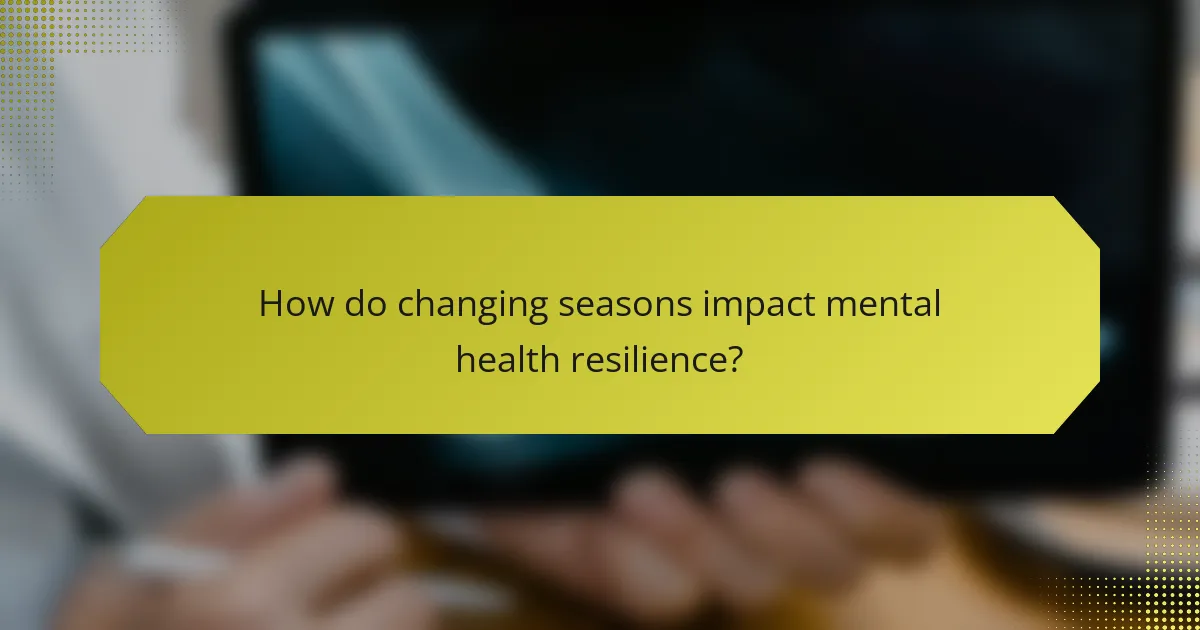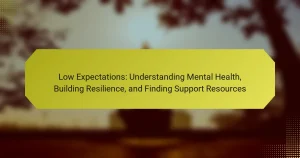Changing seasons can significantly impact our lifestyle and mental health resilience. Seasonal changes influence mood, energy levels, and social interactions. Exposure to sunlight affects serotonin production, which is crucial for mental well-being. Understanding these effects and adapting routines can help mitigate challenges like seasonal affective disorder and enhance overall resilience.

How do changing seasons impact mental health resilience?
Changing seasons significantly influence mental health resilience by altering mood, energy levels, and social interactions. Seasonal changes can lead to variations in exposure to sunlight, which affects serotonin production, impacting overall mental well-being.
Research indicates that individuals may experience seasonal affective disorder (SAD) during winter months due to reduced sunlight, leading to symptoms such as depression and fatigue. Conversely, spring and summer often enhance mood and energy, promoting outdoor activities and socialization.
Maintaining a healthy lifestyle throughout the seasons, including regular exercise and social engagement, can bolster mental health resilience. Adapting routines to seasonal changes, such as incorporating light therapy in winter, may also mitigate negative effects.
In summary, understanding the relationship between seasonal changes and mental health is crucial for developing effective coping strategies and enhancing resilience.
What are the universal effects of seasonal changes on lifestyle?
Seasonal changes significantly impact lifestyle and mental health resilience. These effects include shifts in mood, energy levels, and social interactions.
During spring and summer, increased daylight enhances mood and encourages outdoor activities. As a result, people often report higher energy levels and improved mental well-being.
In contrast, autumn and winter may lead to feelings of sadness or isolation due to shorter days and colder weather. This can affect motivation and social engagement, increasing the risk of seasonal affective disorder (SAD).
Adapting to these seasonal shifts through lifestyle changes, such as exercise and socialization, can bolster mental health resilience. Embracing seasonal activities fosters connection and enhances overall well-being.
How does sunlight exposure influence mood and energy levels?
Sunlight exposure significantly boosts mood and energy levels by increasing serotonin production. This neurotransmitter enhances feelings of happiness and well-being. Seasonal changes impact sunlight availability, affecting mental health resilience. During winter, reduced sunlight can lead to seasonal affective disorder (SAD), characterized by low energy and mood. Conversely, more sunlight in spring and summer correlates with improved mental health. Regular exposure to natural light promotes better sleep patterns, further enhancing overall energy levels.
What are common seasonal affective disorders and their symptoms?
Common seasonal affective disorders include major depressive disorder with seasonal pattern and winter blues. Symptoms often consist of low energy, irritability, changes in sleep patterns, and difficulty concentrating. These conditions typically arise during fall and winter months due to reduced sunlight exposure. As a result, individuals may experience a decline in mental health resilience.
What unique challenges do different seasons present for mental health?
Changing seasons can significantly impact mental health due to variations in sunlight, temperature, and social activities. Seasonal Affective Disorder (SAD) often arises in winter months, leading to symptoms like depression and fatigue. Conversely, spring and summer may enhance mood and energy levels, fostering social interactions. Autumn can evoke feelings of nostalgia, impacting emotional well-being. Adaptation strategies, such as light therapy and outdoor activities, can mitigate these seasonal challenges. Understanding these dynamics is crucial for maintaining mental health resilience throughout the year.
How do winter months affect social interactions and motivation?
Winter months can decrease social interactions and motivation due to shorter daylight hours and colder temperatures. Seasonal Affective Disorder (SAD) affects around 5% of adults in the U.K., leading to feelings of depression and lethargy. Reduced sunlight impacts serotonin levels, which can lower mood and energy. As a result, people may withdraw socially, affecting relationships and community engagement.
What are the impacts of summer heat on mental well-being?
Summer heat can negatively impact mental well-being by increasing irritability, anxiety, and depressive symptoms. High temperatures can disrupt sleep patterns and reduce outdoor physical activity, which are crucial for mental health. Studies show that prolonged exposure to heat can lead to heightened stress levels and decreased cognitive functioning. Additionally, individuals with pre-existing mental health conditions may experience exacerbated symptoms during extreme heat events.
What rare seasonal phenomena can influence mental health?
Rare seasonal phenomena can significantly influence mental health by triggering emotional responses. Events like the sudden arrival of an unusually warm winter or unexpected heavy snowfall can disrupt routines and affect mood. These phenomena can lead to feelings of isolation or anxiety, particularly in individuals sensitive to environmental changes. Additionally, phenomena such as seasonal affective disorder (SAD) are linked to variations in daylight, impacting mental health resilience. Understanding these rare occurrences can help in developing coping strategies.
How do sudden weather changes affect anxiety levels?
Sudden weather changes can significantly increase anxiety levels. Fluctuations in temperature and atmospheric pressure may trigger stress responses, impacting mental health resilience. Studies indicate that individuals with pre-existing anxiety disorders are particularly sensitive to these changes, experiencing heightened symptoms. Seasonal transitions often correlate with mood variations, further complicating mental well-being.
What are effective coping strategies for seasonal mental health challenges?
Effective coping strategies for seasonal mental health challenges include maintaining a routine, engaging in physical activity, and seeking social support. These strategies enhance resilience and mitigate mood fluctuations.
1. Maintain a Routine: Establishing a daily schedule provides stability and predictability, which can alleviate anxiety.
2. Engage in Physical Activity: Regular exercise boosts mood by releasing endorphins and reducing stress.
3. Seek Social Support: Connecting with friends or family fosters a sense of belonging and can provide emotional relief.
4. Practice Mindfulness: Techniques like meditation help in managing stress and improving overall mental well-being.
5. Light Therapy: Exposure to bright light can counteract seasonal affective disorder (SAD) symptoms.
6. Nutrition: A balanced diet supports mental health, with omega-3 fatty acids and vitamins playing crucial roles.
How can lifestyle adjustments improve resilience during seasonal transitions?
Lifestyle adjustments can significantly enhance resilience during seasonal transitions by promoting mental well-being. Engaging in regular physical activity boosts endorphins, improving mood and reducing anxiety. Nutrition plays a pivotal role; a balanced diet rich in vitamins supports cognitive function and emotional health. Mindfulness practices, such as meditation and yoga, foster emotional regulation and stress management. Establishing consistent sleep patterns enhances overall resilience, allowing the body to adapt to seasonal changes more effectively. Social connections provide support, reducing feelings of isolation during transitions. These adjustments collectively build a robust mental framework, enabling individuals to navigate seasonal shifts with greater ease.
What role does community support play in managing seasonal mental health?
Community support significantly enhances mental health management during seasonal changes. It provides emotional connections, reduces feelings of isolation, and fosters resilience. Engaging with supportive groups can lead to shared experiences, offering practical coping strategies. Research indicates that individuals with strong community ties report better mental health outcomes, especially during seasonal transitions. Establishing these connections can be a unique attribute of effective mental health resilience strategies.
What expert insights can guide seasonal mental health management?
Expert insights for managing seasonal mental health emphasize awareness and proactive strategies. Seasonal changes can trigger mood fluctuations and affect mental resilience. Establishing a routine that includes physical activity, exposure to natural light, and mindfulness practices can enhance emotional well-being. Additionally, social connections play a crucial role; maintaining relationships helps combat feelings of isolation. Recognizing patterns in mood changes allows for timely interventions, such as seeking professional support if needed. Prioritising self-care during seasonal transitions fosters resilience and promotes overall mental health stability.
What best practices should individuals adopt for year-round mental health?
To maintain year-round mental health, individuals should adopt practices that enhance resilience against seasonal changes. Regular physical activity boosts mood and reduces anxiety. Mindfulness techniques, such as meditation, improve emotional regulation. Social connections provide support, combating feelings of isolation. A balanced diet rich in nutrients supports brain health. Adequate sleep is crucial for emotional stability. Engaging in hobbies fosters creativity and joy. Lastly, seeking professional help when needed ensures tailored support for mental well-being.
What common mistakes do people make in addressing seasonal mental health issues?
People often overlook their mental health needs during seasonal changes. Common mistakes include neglecting self-care routines, failing to recognize mood shifts, and not seeking professional help. Many underestimate the impact of seasonal affective disorder (SAD), leading to unaddressed symptoms. Additionally, individuals might rely solely on social interactions without considering their emotional health, which can exacerbate feelings of isolation.


